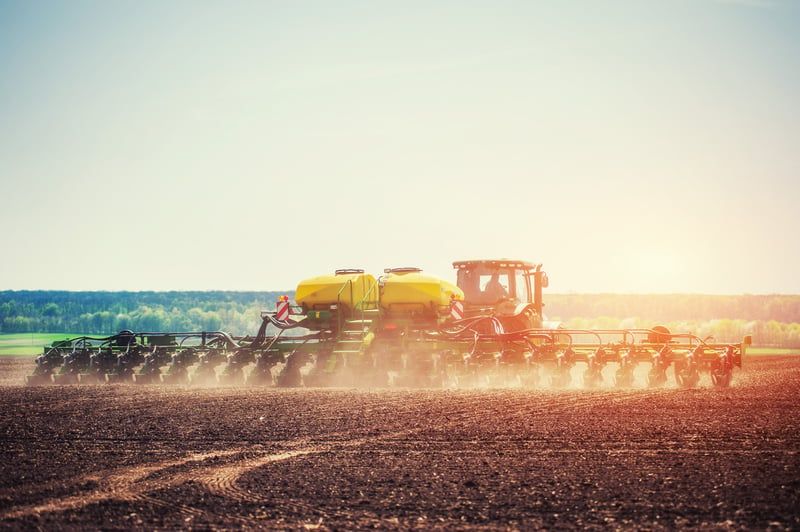Controlling Soil Compaction During Planting
Planting time can be a difficult period on the farm—the weather rarely cooperates, which can keep farmers from entering their fields, and delayed planting eventually starts costing yields. Although it’s easy to feel a sense of urgency at this time of year, farmers should proceed with caution. Fields are particularly prone to soil compaction in the spring, and damage done during planting can not only negatively impact this year’s yields but future crops as well. Keep reading for a few tips to minimize soil compaction at planting.

Planting in Optimal Soil Conditions
One of the easiest ways to prevent soil compaction is to avoid working in wet fields for as long as possible—especially when soil moisture is at, or close to, field capacity. Field capacity is reached when the pores in the soil are filled with equal parts of air and water which typically occurs within a day or two of the field being saturated. Field capacity is the ideal condition for compaction to occur.
Water in saturated soils acts as a lubricant, allowing soil particles to slide around and fill in the voids, which why road-building teams—who, unlike farmers, are trying to compact soils—wet their sites to 80% of field capacity before turning loose the compactors and rollers. Why 80% of field capacity? Because fully saturated soils (soils with their pores completely filled with water) are less likely to be compacted as the water-filled pores are capable of supporting the weight of heavy equipment. Unfortunately, planting on saturated soils can lead to a host of other issues, most notably rutting and sidewall compaction in the furrow.
Ideally, farmers should wait for drier soils before operating heavy planting equipment in their fields to prevent compaction. Drier soils have a higher proportion of air-filled pores which, according to the University of Wisconsin Extension, act like suspension, better support heavy farm machinery, and prevent soil particles from smashing together.
A Simple Test for Soil Conditions
A simple way to judge whether a field is ready to support heavy equipment to collect a handful of soil from the top two or three inches of the ground, mold it into a ball, and see if the ball crumbles apart or deforms. If the ball crumbles or cracks, the field is ready for equipment, but if it deforms, the field will benefit from being given time to further dry.
Tire Size and Inflation
Soil compaction is caused by the weight of a machine exerting force on the ground, and one of the simplest ways to reduce the impact of a machine is by spreading its weight over a larger area. Because of this, it’s important for equipment to operate using properly sized tires inflated to the correct tire pressure. Larger tires operated at lower air pressures are vital to a field’s well being, as they produce a larger footprint—distributing the weight of equipment over a larger surface area—minimizing compaction caused by heavy farm machinery.
Many farmers have turned to radials and high-tech IF/VF tires for their ability to maximize footprint size and operate at low inflation pressure. Radial tires are designed to provide a longer more uniform footprint than a standard bias tire—improving traction and reducing compaction. IF/VF tires can operate between 20% and 40% lower air pressures than conventional radials (or carry 20% to 40% more load at the same inflation pressure). Because of this, IF/VF tires produce a large contact patch that spreads the weight of hulking planting equipment over a greater area than a standard radial farm tire.
Even if you have the perfect field conditions and a machine outfitted with a just-right set of tires, get in the habit of checking tire pressure before entering the field. This is especially true in fickle spring weather, as every ambient temperature fluctuation of 10 degrees can result in 1 psi pressure change in a tire.
Axle Loads
Reducing axle load is another sound strategy for lessening soil compaction at planting. According to the University of Minnesota Extension, farm machinery with loads between 18 and 40 tons per axle can create compaction two or three feet down, while axle loads under 10 tons contain compaction to the top six to ten inches. Restricting compaction to the very top of the soil is key, as it can be broken up by normal tillage, cover crops, and the freeze-thaw cycle.
Conclusion
Being patient and waiting for optimal conditions before entering the fields can have a positive long-term effect on a farm. However, waiting for drier soil isn’t always an option, increasing the importance of reducing the impact of farm equipment on the field. In fact, according to many studies—such as this one from Purdue University—future springs could be getting even wetter, which means taking steps to minimize soil compaction at planting could be even more important going forward. Contact your local dealer or your representative to learn more about how our flotation and IF/VF tires can help your operation minimize compaction at planting.
Contact your local dealer or your representative to learn more about how our flotation and IF/VF tires can help your operation minimize compaction at planting.

